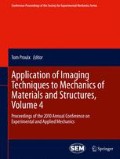Abstract
Computer models of head-brain biomechanics offer enormous potential for improved understanding and prevention of traumatic brain injury (TBI). However existing computer models remain controversial because their predictions have yet to be rigorously compared to measured biomechanical data. The nonlinear, anisotropic, viscoelastic, heterogeneous character of brain tissue, and the intricate connections between the brain and skull, all complicate modeling efforts. In order to make progress toward the goal of accurate simulation of TBI, experimental techniques to address these issues must be developed. In this paper we describe two magnetic resonance (MR) imaging techniques to characterize brain deformation, estimate brain material properties, and illuminate the boundary conditions between brain and skull. MR tagging is used to estimate displacement and strain fields in response to rigid-body acceleration of the skull, and MR elastography is used to visualize shear wave propagation induced by oscillatory loading at the surface of the skull.
Access this chapter
Tax calculation will be finalised at checkout
Purchases are for personal use only
Preview
Unable to display preview. Download preview PDF.
Reference
Thurman D.. The epidemiology and economics of head trauma. In: Miller L, Hayes R, eds. Head Trauma: Basic, Preclinical, and Clinical Directions. John Wiley and Sons. New York. 2001.
Sosin DM, Sniezek JE, Thurman DJ. Incidence of mild and moderate brain injury in the United States: 1991. Brain Inj.10(1):47-54.1996.
Graham DI, Adams JH, Nicoll JAR, Maxwell WL, Gennarelli TA (1995) The nature, distribution and causes of traumatic brain injury. Brain Pathology 5:397–406
Shaw NA (2002) The neurophysiology of concussion. Progress in Neurobiology 67:281–344
Holbourn AHS (1943) The mechanics of head injuries. Lancet 2:438–441
Margulies SS, Thibault LE, Gennarelli TA (1990) Physical model simulations of brain injury in the primate. J Biomech 23:832–836
Meaney DF, Smith DH, Ross DT, Gennarelli TA (1995) Biomechanical analysis of experimental diffuse axonal injury in the miniature pig. J Neurotrauma 12(4):689–695
Hardy WN, Foster CD, Mason MJ, Yang KH, King AI, Tashman S (2001) Investigation of head injury mechanisms using neutral density technology and high-speed biplanar X-ray. Stapp Car Crash Journal 45:337–368
Margulies SS, Meaney DF (70) Brain tissues. In: Handbook of Biomaterial Properties. J. Black and G. Hastings, (ed) Chapman and. London, Hall, pp 80–1998
Ruan JS, Khalil T, King AI (1991) Human head dynamic response to side impact by finite element modeling. J Biomech Eng 113(3):276–283
Zhang L,Yang KH, King AI.A proposed injury threshold for mild traumatic brain injury. 126:226-236. 2004.
Kleiven S (2006) Evaluation of head injury criteria using a finite element model validated against experiments on localized brain motion, intracerebral acceleration, and intracranial pressure. International Journal of Crashworthiness 11:65–79
Takhounts EG, Eppinger RH, Campbell JQ, Tannous RE, Power ED, Shook LS (2003) On the development of the SIMon finite element head model. Stapp Car Crash Journal 47:107–33
von Holst KS, H. (2002) Consequences of head size following trauma to the human head. Journal of Biomechanics 35:153–60
Zerhouni EA, Parish DM, Rogers WJ, Yang A, Shapiro EP (1988) Human heart tagging with MR imaging – a method for noninvasive assessment of myocardial motion. Radiology 169(1):59–63
Axel L, Dougherty L (1989) MR imaging of motion with spatial modulation of magnetization. J Biomech 171(3):841–845
Bayly PV, Cohen TS, Leister EP, Ajo D, Leuthardt EC, Genin GM. Deformation of the human brain induced by mild acceleration. J. Neurotrauma 22(8):845-856. 2005. 127
Sabet AA (2008) Christoforou E, Zatlin B, Genin GM. Bayly PV Deformation of the human brain induced by mild angular head acceleration J Biomech 41:307–15
Muthupillai R, Lomas DJ, Rossman PJ, Greenleaf JF, Manduca A, Ehman RL (1995) Magnetic resonance elastography by direct visualization of propagating acoustic strain waves. Science 269:1854–1857
McCraccken PJ, Manduca A, Felmlee J, Ehman RL (2005) 2005. Mechanical transient-based magnetic resonance elastography Mag Res Med 53:628–639
Sinkus R, Tanter M, Catheline S, Lorenzen J, Kuhl C, Sondermann E, Fink M (2005) Imaging anisotropic and viscous properties of breast tissue by magnetic resonance elastography. Mag Res Med 53:372–387
Naunheim R, Bayly PV, Standeven JW, Neubauer JS, Lewis LM, Genin GM, Linear and angular
accelerations during heading of a soccer ball, Med Sci Sports Exer, 35(8):1406-12, 2003.
Osman NF, McVeigh ER, Prince JL (2000) Imaging heart motion using harmonic phase MRI. IEEE Trans Med Imaging 19(3):186–202
Atay SM, Kroenke C, Sabet A, Bayly PV (2008) Measurement of the dynamic shear modulus of mouse brain tissue in vivo by magnetic resonance elastography. Journal of Biomechanical Engineering 130(2):021013
Author information
Authors and Affiliations
Corresponding author
Editor information
Editors and Affiliations
Rights and permissions
Copyright information
© 2013 The Society for Experimental Mechanics, Inc.
About this paper
Cite this paper
Bayly, P.V. et al. (2013). Measurement of Brain Biomechanics in vivo by Magnetic Resonance Imaging. In: Proulx, T. (eds) Application of Imaging Techniques to Mechanics of Materials and Structures, Volume 4. Conference Proceedings of the Society for Experimental Mechanics Series. Springer, New York, NY. https://doi.org/10.1007/978-1-4419-9796-8_15
Download citation
DOI: https://doi.org/10.1007/978-1-4419-9796-8_15
Published:
Publisher Name: Springer, New York, NY
Print ISBN: 978-1-4419-9528-5
Online ISBN: 978-1-4419-9796-8
eBook Packages: EngineeringEngineering (R0)

